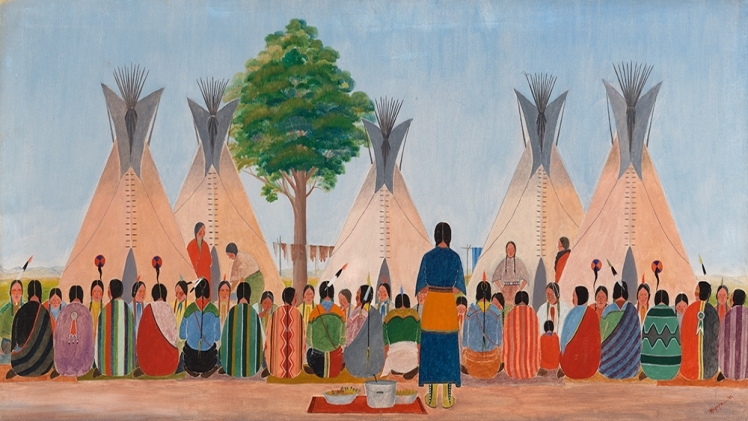Native American paintings offer a vibrant and intricate view into the diverse cultures, traditions, and histories of Indigenous peoples in North America. This art form, deeply rooted in storytelling and spiritual beliefs, serves as a window into the soul of America’s first inhabitants, reflecting their relationships with the land, the spiritual world, and each other.
The earliest Native American paintings were not found on canvas but on rock walls, pottery, and other objects. These petroglyphs and pictographs, dating back thousands of years, depict scenes from daily life, spiritual visions, and symbols significant to various tribes. Such artworks offer invaluable insights into the social structure, religious beliefs, and cosmology of ancient Native American societies.
As European contact introduced new materials and influences, Native American art evolved. The introduction of paper and canvas allowed for the adaptation of traditional motifs into new forms. Despite these changes, Indigenous artists maintained a strong connection to their cultural heritage, incorporating traditional symbols and themes into their work.
The use of color in Native American paintings is particularly significant. Colors are not chosen merely for aesthetic reasons but often carry symbolic meanings. For example, black might represent death or earth, while blue could symbolize the sky or water. These colors, imbued with deep cultural significance, add layers of meaning to the artwork.
Animal motifs are a common theme in Native American paintings, reflecting the close relationship between Indigenous peoples and the natural world. Animals are not only depicted for their physical beauty but are often symbolic of spiritual guides, clan identities, or historical narratives.
The Ledger Art of the Plains Indians is a notable example of how Native American painting traditions adapted over time. Originating in the 19th century, these artworks were created on the pages of ledger books provided by European settlers. Despite the non-traditional medium, artists depicted scenes of battle, hunting, and ceremonial life, preserving their culture’s stories in the face of adversity.
In the Southwest, the Pueblo people developed a distinct style of painting related to their religious ceremonies and cosmological beliefs. These intricate designs, found on pottery, murals, and kiva walls, showcase a sophisticated understanding of geometry and symbolism.
The 20th century saw a renaissance of Native American painting, driven by artists who sought to revive and reinterpret traditional themes for a modern audience. The Santa Fe Indian School, established in the 1920s, played a pivotal role in this movement, encouraging students to explore their cultural heritage through art.
Among the most influential figures of this era was the Kiowa artist Stephen Mopope, who, along with other members of the Kiowa Five, gained international recognition for his paintings that blended traditional Native American motifs with modern artistic techniques.
The Navajo painter, R.C. Gorman, known as the “Picasso of American Indian artists,” brought a contemporary twist to Native American painting. His work, characterized by fluid forms and vibrant colors, celebrates the strength and beauty of Native women.
Contemporary Native American artists continue to push the boundaries of traditional and modern art forms. Artists like Jaune Quick-to-See Smith and Fritz Scholder have used their work to address complex issues such as identity, colonization, and environmentalism, challenging stereotypes and sparking dialogue.
The influence of Native American paintings extends beyond the art world, contributing to a broader understanding and appreciation of Indigenous cultures. Museums, galleries, and cultural institutions increasingly recognize the importance of these artworks, not only as aesthetic objects but as vital expressions of a living culture.
Despite this growing recognition, Native American artists often face challenges in preserving their traditions and gaining equal representation in the art world. Issues of cultural appropriation and the commercialization of Indigenous symbols highlight the need for respectful engagement and support for Native artists.
Educational programs play a crucial role in fostering appreciation for Native American paintings. By integrating Indigenous art and history into school curricula, students can gain a deeper understanding of the rich cultural heritage that these works represent.
Online platforms and social media have also opened new avenues for Native American artists to share their work with a global audience. Through websites, virtual galleries, and digital storytelling, artists can bypass traditional barriers and directly connect with viewers.
Art initiatives and residencies focused on Indigenous artists provide vital support, offering opportunities for creative exploration, collaboration, and cultural exchange. These programs not only benefit the artists but also enrich the broader art community with diverse perspectives and voices.
The preservation of Native American paintings and the sites where ancient art is found is an ongoing challenge. Environmental threats, vandalism, and the illicit trade of artifacts endanger these irreplaceable cultural treasures. Efforts to protect and restore these sites are critical to maintaining the connection between past and present Indigenous cultures.
Collaborations between Native American communities, museums, and cultural organizations are essential in ensuring that Indigenous art is presented and interpreted in a manner that respects cultural traditions and knowledge. Such partnerships can also facilitate the return of sacred objects and artworks to their rightful communities.
Art festivals and markets, such as the Santa Fe Indian Market, play a significant role in celebrating and promoting Native American paintings. These events not only provide a platform for artists to showcase their work but also foster a sense of community and cultural pride.
The impact of Native American paintings on American art history is profound, challenging conventional narratives and highlighting the diversity and complexity of Indigenous cultures. As scholars and enthusiasts delve deeper into this rich artistic tradition, new stories and interpretations emerge, broadening our understanding of American identity.
In conclusion, Native American paintings embody the resilience, creativity, and spiritual depth of Indigenous cultures. From ancient petroglyphs to contemporary canvases, these artworks tell stories of connection to the land, the divine, and each other. As we appreciate and support Native American art, we contribute to the preservation and revitalization of a cultural legacy that enriches us all.

